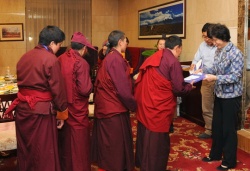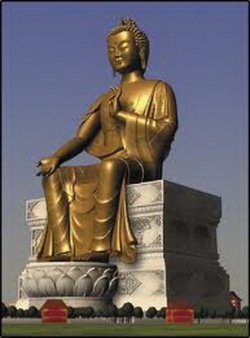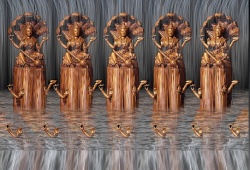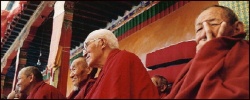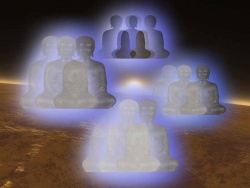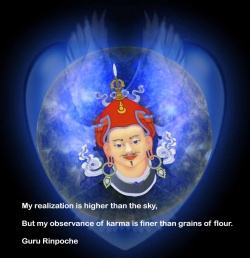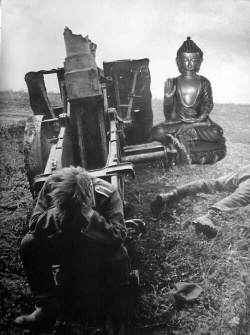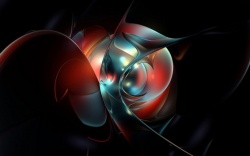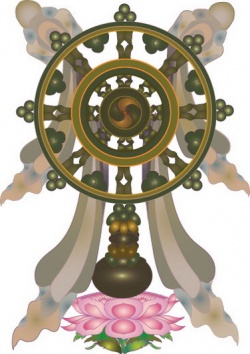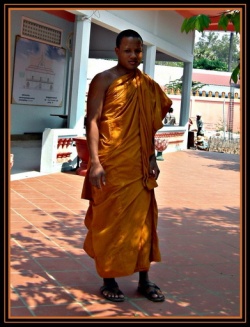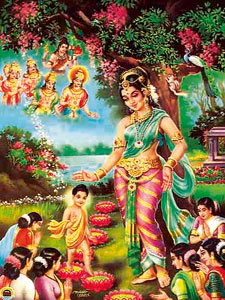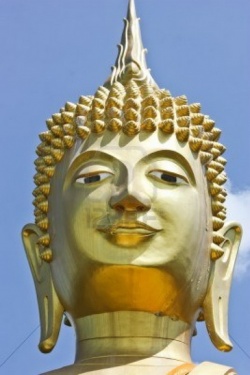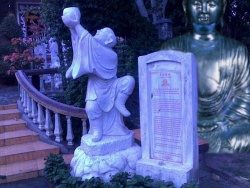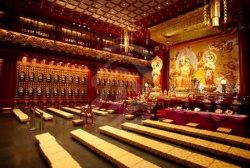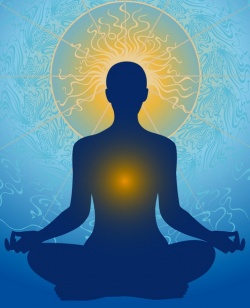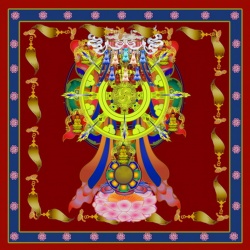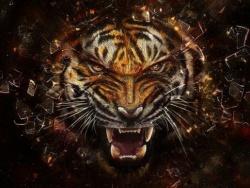What Is Guhyasamaja Practice?
Dr. Alexander Berzin
This evening I’ve been asked to speak about the Guhyasamaja system of the highest class of tantra, anuttarayoga. My Background in Guhyasamaja
Let me begin by telling you a little bit of the history of my own involvement with it. I first started studying the Guhyasamaja system in 1968 when I was at Harvard University as a graduate student. At that time we had a class in which we were reading the first chapter of Guhyasamaja, comparing the Sanskrit, Tibetan, and Chinese versions. My friend Bob Thurman was in the class with me; we were schoolmates together at Harvard. And I was very drawn to the system – I liked it very much – although of course we had no idea of what really it meant or what was involved. We were primarily looking at the way that it was translated. But my professor, Dr. Nagatomi, a Japanese professor, suggested that I study the Guhyasamaja system for my doctorate dissertation and write about it. So I received a Fulbright fellowship to go to India to study Guhyasamaja with the Tibetans. But I had only studied the written Tibetan language. I didn’t know the spoken language. And there were no textbooks at that time, so like an anthropologist I had to figure out the sound structure and learn the spoken language once I got to India.
I met Tsenzhab Serkong Rinpoche in January of 1970 – he eventually became my main teacher along with His Holiness the Dalai Lama – and I asked his advice about whom I could study this system with (although I was obviously totally unqualified to do this). And he suggested that I study it with one of the retired abbots of Lower Tantric College because he was living in Dalhousie, where I was staying in the very beginning of my stay in India. But he was doing a three-year retreat at the time, and he said, “He’ll finish in May, so you can go see him in May when he gets out of retreat.” So this suited me very well because I needed to get my spoken Tibetan up to the level in which I could actually study with him.
Meanwhile, I received the empowerment from Ling Rinpoche, His Holiness’s senior tutor. I think I received it before I asked him. I don’t remember exactly. Maybe it was a little bit afterwards, but it was together at that time. But in any case, I went to see the abbot when he got out of retreat, and he said, “It’s wonderful that you would like to study this. After a week I’m going to go into my next three-year retreat, and this will be on Guhyasamaja.
Would you like to join me in this three-year retreat?” And I realized that obviously this was way over my head, and I said, “No, I need to prepare myself more,” which was obviously what Serkong Rinpoche knew would happen, which is why he sent me to this abbot. And so then I went to see Trijang Rinpoche, the late junior tutor of His Holiness, and he suggested, “Why don’t you study lam-rim?” That was before anything was translated into Western languages, before Jewel Ornament or anything like that. So I decided that I would change my dissertation topic to the oral tradition of lam-rim instead of Guhyasamaja and put off my studies till later.
And actually now I remember more precisely. It was after that that I received the Guhyasamaja initiation for the first time. This was a wonderful occasion. It was in 1971 actually, and it was the last time that His Holiness the Dalai Lama was the disciple, the main disciple, for receiving the three major initiations – Trijang Rinpoche gave the Chakrasamvara initiation, and Ling Rinpoche gave Guhyasamaja and Yamantaka. This was quite a special occasion.
And after that, I’ve received the initiation quite a few times from His Holiness and received several discourses by His Holiness on the Guhyasamaja generation stage – I’m not sure which text that was based on – and His Holiness’s discourse on Tsongkhapa’s text on the five-stage complete stage of Guhyasamaja, A Lamp for Clarifying the Five Stages (Rim-lnga gsal-sgron). And I studied it quite extensively with Tsenzhab Serkong Rinpoche, who’s the so-called assistant tutor of His Holiness. So with him I studied four different texts on the generation stage, Tsongkhapa’s text on the complete stage, and Gyu Sherab-senggey’s commentary, An Extensive Explanation of “Illuminating Lamp” (sGron-gsal rgya-cher bshad-pa) on the first chapter of the Guhyasamaja Root Tantra (gSang-ba ’dus-pa rtsa-rgyud).
So I’ve been involved with this system more of less for quite a long time. And it’s a very, very extensive system with a tremendous amount of literature. Tsongkhapa considered this to be the main tantra within the system that follows from him, that he established, and he wrote the most about it (five volumes of his collected works are his commentaries on Guhyasamaja). The History of Guhyasamaja
So where does this tantra come from? Some scholars, Western scholars, say that it first appeared in the early 8th century. The first reference to it in the literature is in a text by a Sogdian monk. His name was Amoghavajra, he was a translator into Chinese, and he lists eighteen texts in Chinese, and Guhyasamaja was one of them (it was translated into Chinese). He wrote that in the mid-8th century. Sogdians were the main merchants of the Silk Route, and they did a lot of translating into Chinese. Sogdia is what is currently Uzbekistan.
So you have different versions now. You have a version in terms of history by Western scholars, and then you have the traditional Buddhist version of the history. The traditional version is that Buddha manifested as Vajradhara and taught the Guhyasamaja system to King Indrabhuti, who was King of Oddiyana, Ogyen (U-rgyan) in Tibetan, which is the same place where Guru Rinpoche came from much later.
How do we approach this as Westerners? Because then from Indrabhuti, you get many different lineages. And not only from Indrabhuti. If you look at lineages, you have a lineage of the root tantra (this is the one from Indrabhuti), and you have a lineage of the initiation, you have a lineage of the generation stage and sadhana. In the lineage prayer for Guhyasamaja in the sadhana, it goes from Vajradhara to a manifestation of Manjushri to Nagarjuna, so a completely different time in history. And then you have a lineage of the complete stage as well. So what is this?
First we have to really divest our view of history from our Western biblical traditions. It’s not that Buddha, like God, revealed the truth to Jesus or to Moses or to Muhammad as the prophet, and now you have the word of God, and so this is the word of Buddha (as Vajradhara) being passed down to the masses. It’s not like that. Coming from our tradition, it’s very easy to think of this type of revelation, as it were, from Vajradhara according to that analogy of biblical revelations. And what does that type of overlay lead to? It leads to a very sectarian view – that this is the highest, this is the best, this is the real truth, the final truth.
But it’s not like that in Indian traditions, whether we speak in terms of Buddhism or Hinduism. Their view of history is very different. Our view of history tends to be very linear and based on objective facts and records, whereas an Indian view of history is very much mixed with myth, what we would call myth. So from an Indian point of view, Krishna with the cow maidens and so on is as real as King Ashoka. So when we look at history, it’s supposed to illustrate something, teach us something, not just record facts. And in terms of tantra… and not just tantra, but even with Mahayana sutras and so on that have many great masters either receiving direct things from Vajradhara in various manifestations, or Buddha teaching to somebody that then gives it to the nagas and then it’s returned, or going up to some Tushita heaven and getting teachings from Maitreya, and these sorts of things. The Buddhist stuff is filled with that – Mahayana, and tantra within Mahayana.
Vajradhara as a tantra form of Buddha is a manifestation of the clear-light mind that we all have. So within an Indian context, we all the ability to understand the truth – ways that will lead to liberation and enlightenment. We all have that ability because we all have clear-light minds. So anybody who has that type of revelation or understanding is receiving this from Buddha Vajradhara, because Buddha Vajradhara is not a historical figure from our objective Western point of view of history. And the person who receives that revelation first and passes it down is not some sort of final prophet or anything like that – an object of reverence and respect, of course, but not in the same way as Jesus Christ or Muhammad.
So I think this is important to understand when we look at tantra systems like Guhyasamaja and we look at this amazing maze of lineages that come from it and you count the figures in the lineage and it doesn’t add up. There are too few figures and too much of a gap in history. And His Holiness says it very nicely when people question the traditional Buddhist presentation that tantra material, like Mahayana material, was passed down orally in a secret fashion until it was finally written down and made more public: If your reason for saying that is simply “I don’t think so,” that’s not a valid reason; that doesn’t disprove it. Enough about that topic.
Guhyasamaja as a Father Tantra
In any case, Guhyasamaja is considered one of the oldest, if not the oldest, tantra systems to surface in written form in India. And within the classification of tantra, the way that it’s classified in the so-called New Translation period (gSar-ma) is anuttarayoga tantra, which means that it’s dealing with the systems of the subtle body – chakras, channels, winds, these sorts of things – in order to gain access to the subtlest level of mental activity, so-called clear-light mind, and using that level of mental activity as the immediate cause for the Four Bodies of a Buddha.
Now, anuttarayoga tantra is divided into several classes, and one could do a whole historical survey of the different ways in which it has been divided and the reasons for classifying it in one way or another. But in any case, if we come down to the system that was started by Tsongkhapa, he divides anuttarayoga tantra into father and mother tantra (pha-rgyud and ma-rgyud). And the basis that he uses for that division is that father tantra has the most detail about what’s called the illusory body (sgyu-lus) as the cause that will transform into the Form (physical) Bodies of a Buddha, and mother tantra puts emphasis on practices for attaining clear-light mind. From another point of view, father tantra has most emphasis on the various yogas dealing with the energy-winds for getting down to the subtlest level, and mother tantra has a great deal of detail of how to work with the increasing levels of blissful awareness within the central channel in order to get down to the clear-light mind with practices like tummo (gtum-mo), inner heat.
So Guhyasamaja is the main system in father tantra. It has tremendous detail about how to work with the energy-winds within the chakras and channels, and so on, in order to get down to the subtlest level, and it has great detail about how you transform or get the subtlest level of wind or energy that is the mount of the clear-light mind – how you get that to appear in the form of illusory body, which will eventually then become a Form Body of a Buddha. So if you divide the systems in general between method and wisdom, so-called method and wisdom, Guhyasamaja puts more emphasis on the method side.
In the major system of Guhyasamaja that’s practiced in the Gelugpa tradition, we have thirty-two deities. And just as an example of the emphasis on the method side: Within the sadhana, the method that’s done on the first stage of practice, the generation stage (bskyed-rim), in which you work with imagination, as a Buddha-figure you imagine that you are emanating each of these thirty-two figures and each of them is helping others to eliminate one or another type of disturbing emotion or one or another type of interference. So it’s a wonderful system for developing an appreciation within yourself of the fact that you need to manifest in many, many different ways to help different people with their own individual problems. And being such an extensive system with such an extensive literature, it provides what’s known as the template for anuttarayoga tantra practice, both the generation (bskyed-rim) and complete stage (rdzogs-rim). In other words, it gives the structure that is then followed in all the other tantra systems.
The Meaning of the Name Guhyasamaja
The name Guhyasamaja (gsang-ba ’dus-pa) means “the assembly of hidden or secret factors.” Guhya (gsang-ba) means “secret,” and samaja (’dus pa) means an “assembly.” When we say the word secret, it’s not as though: “Ooh, you have to keep this secret!” That’s not the main flavor of the word. It means that it is naturally hidden or obscure to those who are not ready to be able to understand it, hidden because of its language. But also in terms of teaching it, you should keep it hidden from those who are not ready to understand it.
And the assembly of these hidden factors can refer to all the deities within the system, or it can refer to the three main hidden factors, often called the three vajras – vajra body, vajra speech, and vajra mind – referring to the enlightened or enlightening aspects of these three. There’s two ways of referring to that: In a sense, body, speech, and mind have been developed to the enlightened stage. But they are inspiring to others, so they are enlightening; they can help to enlighten others.
The Lineages
The text themselves. The root tantra (gSang-ba ’dus-pa rtsa-rgyud) is in seventeen chapters. Seven of the chapters were translated into Chinese by Danapala in the year 1002. But the Guhyasamaja rituals and practice never really took off in China, so you don’t really have a tradition there, but the text was – at least the seven chapters – was translated into Chinese. And the root tantra was translated into Tibetan around the same time by the great translator Rinchen Zangpo working together with a Kashmiri pundit called Shraddhakaravarman.
There are six Guhyasamaja explanatory tantras (bshad-rgyud), but only five of them were translated into Tibetan (one of them, called the Guhyasamaja Appendix Tantra gSang-ba ‘dus-pa phyi-rgyud, is considered the eighteenth chapter of the root tantra). And these are on various aspects of the generation and complete stage, but written in a very, very obscure, hidden manner so that only in later Indian commentaries do you get the system for being able to decipher the language and the images with which these texts are written. These texts are filled with passages like “the vajra with the lotus,” and it’s just all images. And as I learned trying to study it at Harvard in the three languages, it almost becomes meaningless if you have no idea what it’s really talking about. It’s very intriguing.
There are four traditions of explaining the root tantra and the six explanatory tantras:
One by Aryadeva, who was a disciple of Nagarjuna
One by Jnanapada, whose full name was Buddhashrijnana
The third by Anandagarbha
The fourth, by Shantipa.
But the first two are considered the best.
The major thing, though, that is usually studied is within the Aryadeva tradition, sometimes abbreviated as the Arya tradition (‘phags-lugs), and here we have a large amount of literature that was written in India in Sanskrit. And interestingly the major authors in it have the name of the major Madhyamaka authors:
Nagarjuna – three texts: two on the generation stage and one on the complete stage, although he didn’t actually finish the one on the complete stage
Aryadeva – two texts, one explaining the meaning of Nagarjuna’s text on the complete stage that he didn’t finish
Another disciple of Nagarjuna, Nagabodhi – three texts
Shakyamitra – one text, which completed Nagarjuna’s text
Chandrakirti – three main texts. Tsongkhapa’s commentary on Chandrakirti’s commentary and then later commentaries, some commentaries on that, form the major thing that is studied within the tantra colleges.
Rahulamitra – one text
Naropa – two texts.
We have again a problem with history. The tradition considers Nagarjuna, Aryadeva, and Chandrakirti as the same authors who wrote the most famous Madhyamaka texts. From the Western scholarship point of view, that doesn’t make sense, so Western scholars say that these were much later authors who, in order to legitimize what they wrote, chose the names of these great Madhyamaka masters. But as I tried to indicate before, the view of history is very different here from the Indo-Tibetan worldview, so it is irrelevant whether it’s the same person or not because the main point is that the understanding and explanation of Guhyasamaja is within the context of Madhyamaka, the Madhyamaka view of reality. It’s the same point as is made by the traditional version of Buddha teaching the Prajnaparamita Sutras on Vultures Peak and simultaneously appearing as Kalachakra in South India and teaching the four classes of tantra from the four faces of Kalachakra. The point is that the tantra systems need to be understood and practiced within the context of the Madhyamaka teachings on voidness.
In Tibet the tradition for explaining the root and explanatory tantra texts, the five explanatory tantras translated into Tibetan, is from Goe Lotsawa (‘Gos Lo-tsa-ba). And the tradition for explaining the guideline teaching in terms of the practice come through Marpa. So there’s a great tradition within the Kagyu line as well of Guhyasamaja practice. We shouldn’t think that this is exclusively a Gelugpa practice; it’s certainly not.
So the Gelug tradition follows both of these lineages, the one from Goe Lotsawa and the one from Marpa. And of the three forms of Guhyasamaja practice, the main one practiced in the Gelugpa tradition has Akshobhya as the main figure. And within that tradition, within the literature Akshobhya sometimes is called Vajradhara and sometimes called Vajrasattva. (Remember I told you this is the template. It gives the structure for all anuttarayoga tantra.) And this is the system with thirty-two deities, and it’s the lineage that comes through Marpa from Tilopa and Naropa.
Then there are two other forms of Guhyasamaja. One is called Jamdor (‘Jam-dor), and that has Manjuvajra – that’s a form of Manjushri – as the central figure, and in its mandala there are nineteen deities. And then there’s a third form, called Jigten Wangchug (’Jig-rten dbang-phyug), and that has a form of Avalokiteshvara as the central figure. And those two lineages come through Goe Lotsawa. I really don’t have any detail about the Jigten Wangchug form of it. Serkong Rinpoche did the retreat for that form of Guhyasamaja just before he died, and it was only a few days after that that he actually passed away, so I never had a chance to ask him about it.
As I said, five of the eighteen volumes of Tsongkhapa’s collected works are on Guhyasamaja, so it’s the main thing that he wrote about – or the thing that he wrote the most about, I should say. It’s the major anuttarayoga tantra in the Gelug system and the main topic studied in the tantric colleges.
And just to indicate how it is a template for the practices, the Six-Session Guru Yoga (Thun-drug-gi rnal-’byor) – which is a practice formulated by the Fourth Panchen Lama for being able to keep the samayas, the close bonds, from anuttarayoga tantra practice – has as its central figure before us Vajradhara, and then we transform into Vajrasattva. This is according to the Guhyasamaja system. These are both blue figures as in the Guhyasamaja practice. They’re not our white Vajrasattva for purification. So that’s the standard form. And then if one wants to do it in a more specialized form, one can substitute the main figures from a different anuttarayoga practice, like Kalachakra or Yamantaka. It doesn’t make any difference. But it’s the template. And the body mandala that’s found in the Lama Chopa (Bla-ma mchod-pa, The Guru Puja) and in this practice The Inseparable Spiritual Master and Avalokiteshvara that I’ll speak about this weekend, again you have the body mandala of Guhyasamaja. So we find Guhyasamaja popping up in all sorts of places within at least the Gelug tradition.
The Eight-Stage Dissolution Process
So what’s so fantastic about this system? we could ask. What is it offering us? One of the main things that we find there is tremendous detail about what is the central practice of anuttarayoga tantra, which is the transformation of death, bardo, and rebirth. So this is the source of the material about the eight-stage process of dissolution when we die.
Complete-Stage Practice
When we talk about mind in Buddhism, we’re talking about mental activity. We’re talking about the subjective individual experiencing of things, knowable things, validly knowable things. So if you think in terms of experiencing, I think that helps us get a little bit closer than just thinking of the word mind, which makes you think of a physical object. It’s not a physical object. We’re talking about subjective experiencing of things that you could know, some content. And there’s always a physical basis for it. So we can describe an event, a cognitive event, from the point of view of experiencing or from the point of view of the physical phenomenon that’s involved, the energy and so on.
There are many levels of mental activity, and this level of subtleness or subtly of the mental activity is directly related to the level of subtlety or grossness of the physical basis. So as we die, the consciousness withdraws from having as its basis the grosser aspects of the body (which is similar to the process of how we fall asleep):
First the earth element can no longer support mental activity, so the solid aspect of the body.
Then the water element, which is referring to the liquid parts of the body.
Then the fire element, so the heat aspects of the body can no longer support mental activity.
And then wind, which is referring to not only gas but also more like an energy level, a grosser sublevel of energy (there are more-subtle levels of energy).
So the mental activity or consciousness is withdrawing – in other words, it has less and less of a solid basis or foundation – and eventually we get down to the clear-light level. Guhyasamaja presents tremendous detail about this process.
We want to simulate that process in meditation on the second stage of anuttarayoga practice, the complete stage, so that we can actually access that subtlest level, the clear-light level, without dying. And then we want to use it because it’s the most efficient level for gaining the non-conceptual cognition of the two truths. Right? This clear-light mind automatically is nonconceptual. It’s more subtle than all the conceptual levels of mind. And it’s on this level that the two truths about things – their voidness and their appearance – can manifest simultaneously. And it doesn’t have grasping for a true existence, so it’s more subtle than that. It’s not enlightened yet, and it doesn’t automatically understand voidness, but it’s the most efficient level of mental activity with which to gain that realization (if we’ve built up tremendous habits beforehand through sutra practice). So Guhyasamaja gives all the detail for how to attain that level by working with the energy-winds and, in a sense, dissolving these winds so that you get the mental activity no longer riding on them.
So we imagine coming down to the clear-light level – so the eight-step dissolution process – and we get a conceptual cognition of voidness. So you apply that in your imagination with being on that clear-light level.
Translator: That’s conceptual?
Alex: Sure, it’s conceptual.
And then from the subtlest wind or energy of that clear-light level, instead of attaining bardo after death, you imagine that you attain Sambhogakaya, so a Form Body of a Buddha that can teach arya bodhisattvas. And then you imagine arising in a full form as a substitute for taking rebirth, which will then be like attaining a Nirmanakaya.
So it’s the template, the major structure of all anuttarayoga practice.
Complete stage (rdzogs-rim) by the way, the second stage, sometimes people translate it [[[rdzogs]]] as completion. That’s not the meaning. The meaning of the word is “complete.” Everything is now complete for being able to actually simulate this process for real with the energy system, to actually get down to that subtle level and so on by working with the energy system, not just in your imagination.
Generation-Stage Practice
And if you want to practice the dissolution process, Guhyasamaja presents the most detail on it in the generation stage as well. The generation stage is when you generate or simulate all the – well, not only the mandala but the deities, all the various aspects, with your imagination. So we have twenty or twenty-five objects to be purified by this generation stage. These twenty or twenty-five objects that we’re talking about here are:
The five aggregates.
The four elements of the body
The cognitive sensors, six of them. Sensor is referring to the photosensitive cells of the eyes, the sound-sensitive of the ears, and so on.
And the five sense objects – sights, sounds, etc.
So that makes twenty. And then for twenty-five, you would add the basis level of the five types of deep awareness – mirror-like, equalizing, and so on.
So each of these and more are represented by a figure in the mandala. And we have one cluster of them, one assembly of them, externally within the mandala. And then within your body as the central figure, you have all these different aspects represented in the form of these deities. You have thirty-two deities within your body – at one time thirty-one and another time thirty-two at different times within the sadhana – and at one point in the sadhana, you even have also the set of thirty-two within the body of the female figure as well.
So you’ve brought everything in within the body mandala of the main figure. And the point is that when you do the dissolution, you imagine clusters of these figures dissolving into the heart, which mimics what happens during the death process. So in the first four stages of this eight-stage process, you’re going to have an aggregate failing, an element failing, and you’re going to have one of the sensors and the objects of that sensor failing, as happens when you are dying or, on a grosser level, when you fall asleep. And you have various forceful figures on your limbs and so on, and some of them will dissolve at each stage.
So there’s a whole cluster that the consciousness is withdrawing from as it gets more and more subtle, and you try to simulate that. So it’s very, very difficult and challenging to put that all together in your mind – and not just on the level of a visualization, but of what that would actually feel like. But because it has this incredible detail, then you really train yourself to recognize what is happening during that death process, which you want to simulate not just in imagination on the generation stage, but for real on the complete stage in your meditation.
But of course to do a complete-stage practice, you need the attainment of combined shamatha and vipashyana, the real thing. So absolutely perfect concentration, of course. If you try to manipulate the energies in the body and work with them and you don’t have concentration, you’re in big, big trouble; you can mess up your energies very seriously.
And for vipashyana, there are many ways of developing it in anuttarayoga tantra. It’s something which is attained on top of shamatha. So, for instance, you could visualize a tiny drop at the upper or lower end of the central channel – in Guhyasamaja it’s the lower end – and inside that drop the entire thirty-two-deity mandala of Guhyasamaja, down to the detail of the white and black of their eyes. And then the subtle systems: so you keep the one drop, and then you have two more drops, and then you have four more drops, and then you have eight more drops – and the full mandala’s in each of them – and then you draw it back, in order. And then even better, even more difficult: inside that little drop, inside the main figure in the mandala of the central figure of the mandala inside the drop, at the lower end of its central channel there’s even a tinier drop, and inside that there’s the complete mandala. And you can go further and further and further down.
So let’s not fool ourselves into thinking that: “Oh, I’m such a great practitioner. I can work with the chakras and the channels and so on.” Who are we kidding? This is unbelievably difficult and advanced, because you need this precise laser type of concentration to be able to successfully manipulate and move the energies within the channels of the subtle-energy system. Otherwise you can even go crazy because of messing up the energies. It’s like they do with microsurgery, doing surgery through a microscope and a robot hand. We’re talking about this type of practice on the complete stage. Okay? I still have a lot that I’d like to explain. I mean, there are some incredible things in this system if you really study it in depth.
Now, in the process of the dissolution after you have dissolved from the four grosser levels, then you get what’s sometimes translated as the three appearances (snang-ba gsum) and then clear light. Very difficult terms to translate and get really the flavor. There’s a word that’s translated as appearance in Tibetan, but it actually translates two different words in Sanskrit that both are used in this context. One means “appearance,” and one means a “brilliance.” But it’s not quite even a brilliance; it’s a certain clarity.
First of all, the dissolution process is going into clear light. But then you have the reversal process of coming out of clear light, which describes how we perpetuate samsara – normal rebirth, bardo and then rebirth. So one version of the reversal process, a more subtle level, occurs with attainment of a bardo body, and the full version occurs with attaining a rebirth body.
So these three appearances – sometimes called white appearance, red appearance, and black appearance – are the subtlest level of conceptual minds, and the names are given in reference to the dissolution process:
First you have the word appearance or luminosity (snang-ba). That’s the white one.
And the red one is sometimes translated as increase (mched-pa). But actually the Sanskrit word means a “luster,” which from one point of view is a stronger type of light, but this also is a little bit misleading. It’s difficult to translate.
See, the problem is, how do you translate these words? You get the impression that they’re talking about a stronger intensity of light until you get to the clear light, but that can’t be the case. We’re not talking about intensity of light, like a light bulb and turning up the voltage. So if you look at the explanations in the commentaries, they’re talking about becoming more and more clear. So clear of what? We’re not talking about focus. We’re talking about being clear of an appearance of true existence. So the appearance of true existence, which you get with conceptual cognition, is getting more and more subtle. So it’s becoming clearer getting to the clear-light-mind level, which doesn’t make an appearance of true existence. That’s how you get the terminology.
And the black one, the third one (nyer-thob), is called… I mean, Jeffrey Hopkins translates it as near attainment. It’s like a threshold. You’re almost there at clear light.
And this third one has two levels, two steps: one with mindfulness, one without mindfulness. Tsongkhapa explains that very nicely, very clearly. Mindfulness (dran-pa), that’s the mental glue that allows you to remember something. So what don’t you remember? What don’t you have the mental glue on? What is the variable for mindfulness and without mindfulness? It’s the mindfulness of the mind itself. But it’s not talking about mindfulness that’s involved in concentration. There are practices in Guhyasamaja for meditating on voidness with each of these four levels of mind – these three most subtle conceptual levels and the nonconceptual level of clear-light mind – so you can have mindfulness that’s involved with concentration, but you don’t have mindfulness of the mind itself. I’ll explain what that means.
This is nicely explained in Kalachakra. We have a similar process to the dissolution that occurs in sleep, falling asleep, although you don’t go completely down to the actual definitional clear-light mind. But what is it that appears when you are in deep sleep without dreams? It’s a darkness. Do you remember that darkness when you wake up? No, because you are in something which is similar to this black appearance without mindfulness. You can’t remember the darkness. You can remember dreams, but you can’t remember the darkness, although the darkness appears. And in advanced, advanced practice, you can do voidness meditation in that deep-sleep state – don’t think that’s easy – so you can have the mindfulness for the concentration in that deep sleep, but you wouldn’t remember the darkness.
So if we talk in terms of the reversal sequence (how you get more samsara), what do we have with this system? The energy-winds now are getting grosser, so they are emerging from this clear-light state. Okay? So what are you getting with these grosser levels of mind, these seven stages outside of clear light?
We have what’s called the undissipating drop (mi-shig-pa’i thig-le). One level of that is speaking about the combined subtlest clear-light mind and subtlest energy that goes from lifetime to lifetime. When you take birth like in a human, it joins with a drop of what’s called red and white bodhichitta (byang-sems dkar-po and byang-sems dmar-po) from the mother and father, and the white goes to the forehead chakra, and the red to the navel chakra. What’s happening in the dissolution process is that the white falls back to the heart chakra, which is where the undissipating drop is, and then you have the white appearance. And then the red comes up from the navel chakra to the heart, so you get the red appearance. Then they join again with the undissipating drop, so you get the black appearance, then clear light.
So what in the world is this talking about? This is my current understanding – you don’t find this actually in the texts – just working with this and thinking about this, about what makes sense.
First of all, these are conceptual cognitions. Conceptual cognitions of what? We already have all the grosser conceptual minds dissolving before this (and I’ll explain this in a minute). But what we have left then is that most subtle aspect of conceptual cognition which produces an appearance of true existence. This is what we’re talking about at this level. And being a conceptual cognition – and I confirmed this with my teachers – you have a category, this category of true existence, through which one perceives these three appearances with a more and more subtle movement of the energy-winds that are supporting these three appearance-making minds. Right? The black has the least movement of wind, then you have a stronger movement with red, and an even stronger movement with white. And this is a conceptual cognition that has right in front of it this category. But categories don’t have form, so what represents these subtle levels of appearance making of true existence?
What represents it is an appearance of black, an appearance of red, an appearance of white. And they’re not just the colors, like paint. White is like moonlight reflecting on the snow. Red is like the glow of sunrise or sunset. And black is like night without the sun or moonlight. So my understanding is that this is the representation of these different levels of appearance of solidity, the appearance of true existence.
Now, after the first four steps of the dissolution, when the consciousness is withdrawn from the gross elements of the body and the senses, before you get these three so-called appearance-making minds and the clear light, you have an intermediate step, which is not counted as one of the eight. And here is where you get the eighty universally occurring subtle conceptual minds (rang-bzhin kun-rtog brgyad-cu) dissolving. Universally occurring subtle conceptual levels of mental activity – primitive levels of conceptual activity, one of the more mysterious and fascinating aspects of the teachings on how the mind works. Fantastic.
So now we have to understand that there are three levels of conceptual activity (conceptual is with a category, like the category dog). These eighty are divided into three groups: thirty-three, forty, and nine. And they are indicative – that’s the word – indicative of the white, red, and black appearance-making minds. One group is indicative of the white, one of the red, one of the black. So what does it mean that they’re indicative? It means that each of these three has a different level of movement of the winds, just as these three appearance-making minds have three different levels of movement of the winds. Movement of the winds and the energies, this is really important. If you become very sensitive, you can feel it, you feel it as nervous energy, and you start to become aware then of the different levels of nervous energy and the various wild thoughts and conceptual ideas and disturbing emotions, and so on, that are carried by this nervous energy.
So we’re talking here about primitive concepts that everybody has, including the earthworm. We’re not talking about our individual grosser concepts of my house or whatever. And these include primitive concepts of various positive and negative emotions, like loving concern, hatred, fear. So this is loosely what we in the West would call feelings, like you feel bored or you feel lazy. They also include the primitive concepts of various forms of feeling like doing something or wanting to do something, like to eat something, embrace someone, gather possessions.
You don’t need to learn these; our mental activity gives rise to these universally occurring concepts instinctively with each samsaric rebirth that we take. Our personal gross concepts we have to learn. You have to learn who your mother is or what your house looks like. You don’t have to learn the concept of eating.
So with these types of primitive conceptual activity, we’re not talking about the rough conceptual mental activity involved each time we experience instances of similar emotions that belong in the same category of emotion. Let’s say that every time that I experience fear, I am able to identify that with a general concept, a category of now I’m afraid. We’re not talking about that level. Or that level of hunger. How do you recognize that you’re hungry? It’s through a category, a concept of hunger, that you then identify with this sensation, the physical sensation. Right? We’re talking about something more primitive than that.
So I’m basing my understanding, my analysis – you won’t find this in the books – but I’m basing it on something on Tsongkhapa’s commentary on the five stages of the complete stage. We’re talking about the subtle conceptual process underlying the arising of individual instances of karmic urges or compulsion to perform similar actions that all belong in the same general category of primitive universally occurring actions, like to eat something. All of this is related to karma, compulsion.
You have to have a primitive concept of the action of eating in order for each instance to arise of an urge to eat. Think about this. This is really very fascinating – more than fascinating; it’s fantastic. We’re talking about instinctive concepts here. In terms of samsaric life, there has to be in each individual an instinct of eating or of possessing things in order for the urge to arise – that’s karma – to actually eat something. Why would you want to eat something? How does that work? And then a grosser level of conceptual mind is that every time that you’re eating, you would be able to conceptualize that now I’m eating. That’s a different level. That’s a grosser level.
So this primitive level that just makes the whole mechanism of a samsaric life – that you’re going to eat, that you’re going to feel like eating, or that you’re going to feel fear, or you’re going to feel loving concern or compassion that would allow you to take care of babies – there has to be that to start with on a primitive level before you could actually experience different instances of that as being an act of eating or being afraid. And that is occurring with a certain subtle level of the movement of the energy within the body, the subtle body. And each of these levels of conceptual mind have different grades of movement of the winds, force of the nervous energy.
So this Guhyasamaja system, with its commentaries and its enormous literature, is just opening up a vast world of material to analyze what in the world is going on with samsara, what is going on with how we operate, how we work. It’s fantastic. So even if we don’t get to the level in which we’re actually able to practice and dissolve all this stuff in meditation, still to learn about it is very, very helpful in being able to recognize what is the whole process that is perpetuating my samsaric suffering. If you didn’t have the primitive concept of eating, you would never eat. Why would you eat? And that is really a drag as a samsaric being, that you have to eat all the time, isn’t it? So that’s one aspect, one topic that’s discussed in great detail in Guhyasamaja.
The Six Alternatives and Four Modes
The other big system – which we don’t have time to explain, but I have quite a good article on it on my website – is the system called the six alternatives and four modes (mtha’-drug tshul-bzhi). This is the system of analysis of how you derive all the generation-stage and complete-stage practices from this incredibly obscure language, so-called vajra words, of the root tantra.
[See: Explaining Vajra Expressions: 6 Alternatives & 4 Modes]
So words can have:
Explicit meanings (drang-don) or
Implicit meanings (nges-don)
Metaphorical (dgongs-can) or
Nonmetaphorical (dgongs-min)
Conventional language (sgra ji-bzhin-pa) or
Nonconventional language (sgra ji-bzhin-pa min-pa).
One word can be many of these. And it could have:
A literal meaning (yig-don)
A general, shared meaning (spyi-don)
A hidden meaning (sbas-don)
And a final, ultimate meaning (mthar-thug don).
And one word or one expression could have many of these different levels simultaneously.
As I mentioned, I studied the textbook on the first chapter of the Guhyasamaja Root Tantra that’s used in the tantric colleges – I mean, they study all the chapters (I only studied the first chapter) – in which you derive the entire Guhyasamaja practice from these words. Extraordinary system.
Conclusion
So this is a general overview of Guhyasamaja. I’ve only hit on some of the high points of it. There’s a lot more in it. So when we think of Guhyasamaja practice, we shouldn’t just think in terms of some set of rituals. It’s important to realize that this is a vast system that, as I said, offers the template for what is going on in general in anuttarayoga tantra practice on the generation stage and complete stage. And it has extraordinary detail on the death, bardo, and rebirth process, how to work with it, how to recognize what’s going on. And then there’s the whole apparatus with we can actually derive the meaning of the tantra from the obscure type of language in which it was written.
Questions and Answers
So that brings us to our end of this lecture. Perhaps you have one or two questions.
The Difference between This and Other Hindu Systems
Participant: As I understand it, the dzogrim (complete) stage is what actually brings the result of the path. There are many systems in India – for instance, shadanga yoga – which although not being Buddhist, also work with a dissolution process. So what is the meaning, what is the aim, of using the kyerim (generation) stage? Does it have some different application?
Alex: Okay. First of all, the six-stage yoga, the six-branch yoga, is a structure that can be applied in many, many different systems, both Hindu and Buddhist, to describe what would be the equivalent of complete-stage practices. So in each of these systems, the specific practices of each of the six are quite different, but the name is the same.
The Buddhist versions of it – that you find in Guhyasamaja, you find in Kalachakra, you find in other systems – have of course the distinctive features of bodhichitta and the understanding of voidness. But as it says repeatedly in every commentary, there’s no way that you can have any sort of success on the complete-stage practice without the generation-stage practice, and you can’t have success with generation-stage practice unless you’ve received the initiation, and you can’t have success with the initiation unless you have done all the preliminaries etc. before.
So all the preliminaries are an initial cleansing of obstacles and hindrances and building up some positive force so that the initiation or empowerment can, in a sense, awaken and stimulate the Buddha-nature potentials. Otherwise they’re too obscured; you’re not receptive. And then on that basis, with the generation stage you train with imagination to build up the causes that will ripen – that’s the technical term – into success on the complete stage.
So not only do you build up more positive force and more deep understanding through working with the imagination on the generation stage, not only do you develop perfect single-minded concentration and this united pair of shamatha and vipashyana – all of which are indispensable for success on the complete stage with the six-branch yoga – but by simulating in your imagination the process of how the various things will dissolve in the dissolution process, for instance, it is like training so that you’ll be able to recognize it when it actually happens in meditation. Otherwise it goes too quickly – you have no idea what’s going on – and you won’t be able to do it in meditation.
Think in terms of dzogchen practice, for example. You talk about manifesting rigpa, pure awareness, and this is going to have all appearances – it will be inseparable of voidness and appearance, bliss and appearance, and all these things (you have the same thing in mahamudra). But unless you have built up the causes through mahayoga practice and anuyoga practice, why would these automatic appearances be in the form of the deities that will then form the basis for a Form Body of a Buddha? There has to be a reason. Something built up for it to become like that. The same thing in terms of simulating blissful awareness so that the rigpa will appear in the form of a blissful awareness.
So when we talk about the word ripen (smin-pa), it’s a very significant word. Ripen here means like a fruit, that it has to grow and ripen so that eventually it becomes completely ripe and it will be ready to eat. Success in the six-branch yoga is not going to happen without a cause. So in the generation stage and even earlier you start to build up the causes. It’s like a little fruit, and you add more and more and more to it through the practice so that it will ripen into success on the six-branch yoga and eventually success in becoming a Buddha.
Participant: Could you say a few words about the vajra-breath practice in the Guhyasamaja system?
Alex: There’s another system that Nagarjuna introduced, the five-stage complete-stage practice, and the vajra-breathing practice occurs on the second of these stages, what’s called isolated speech (ngag-dben).
Translator: This is another system compared to the six-branch yoga?
Alex: You can divide complete-stage practice into six-branch yoga. You can divide it into the five-stage practice. There’s a four-step way of dividing it. There’s many different ways of cutting the pie.
So with the first stage, isolated body (lus-dben), what you are trying to do is basically to get the winds, the energies of the senses, to enter into the central channel.
But with the vajra-breathing, the isolated-speech thing, what you are doing is combining the breath with the sound of OM AH HUM. So this is the more definitive level of mantra practice. You are working with the actual process of breathing in and out with the OM AH HUM, which is a way of getting the energies together with the breath in the central channel to go down to the heart chakra. There are many variants of how you do this practice. You find it in many other tantra systems as well. But one of the syllables OM AH HUM will be with the in-breath, one with the staying in the central channel, one with the out-breath. So it’s basically to start to bring the other winds down to the heart chakra once you get the sensory winds into the central channel. It’s not just reciting OM AH HUM in your mind while you’re breathing. It’s much more difficult.
The Abbreviated Sadhana
Participant: I think that most people here have a Guhyasamaja initiation. I think many people have problems doing the abbreviated sadhana, problems mostly associated with visualization of the deities. So could you talk just a little bit about the abbreviated sadhana and how you do it yourself – how much time does it take, and how to do it – so that it would fulfill our commitments and allow us not to break them through that process? So a few words about the abbreviated sadhana.
Alex: That’s a very difficult question. Serkong Rinpoche said that the abbreviated sadhana is for advanced practitioners. You start with the very long one. And only when you are very familiar with the very long one can you then go to the more abbreviated ones and fill in what is abbreviated without having to recite everything that’s in the long sadhana. So to just recite or practice the abbreviated one without knowing what is abbreviated in it is not so easy actually. And eventually you can get to a point where you actually don’t need to recite anything, except mantras and things like that, and you just do the practice in terms of it being in your mind, without having to recite all the words.
And I must confess I’ve never practiced the abbreviated sadhana. I practiced the long one and then the medium one, and it takes a long time.
Participant: It’s just that we only have the abbreviated sadhana translated into Russian. That’s the problem.
Alex: Well, you need to get the longer ones translated.
But what is the main essence of the sadhana? This is very important. It’s not an exercise in visualization. So don’t worry about what all the deities look like and what they’re holding and stuff like that, because it’s unbelievably difficult to be able to visualize all that detail. It’s almost impossible for beginners to be able to do it. And the most problematic thing in sadhana practice is when you get stuck on the details of the visualization because you think that that’s the main thing.
Tsongkhapa says this very clearly. The main thing is the pride of the deity (lha’i nga-rgyal) – on the basis of Buddha-nature and so on, feeling that I can label “me” on my not-yet-happened enlightenment, which is represented by what I visualize. So as Tsongkhapa says in his Letter of Practical Advice on Sutra and Tantra (Lam-gyi rim-pa mdo-tsam-du bstan-pa), just get the general form of the deity and the figures, just vaguely, and emphasize the feeling of “me,” that the conventional “me” is labeled on this. Clarity of the details of the visualization will come automatically as your concentration improves (but obviously you have to have memorized what it looks like).
And the essence of the sadhana is the simulation of death, bardo, and rebirth. That’s the main thing. Through the same mechanism that death, bardo, and rebirth work, you use that same mechanism to imagine Dharmakaya, Sambhogakaya and Nirmanakaya. That’s called taking death, bardo, and rebirth as the pathway for Nirmanakaya, Sambhogakaya, and Dharmakaya. That’s the name of that. So within the abbreviated sadhana, put your emphasis on those points, the feeling of already being what it is that I’m going to attain. That’s why bodhichitta is utterly essential for tantra practice. Bodhichitta is a mind which is focused on our not-yet-happening enlightenment, our individual enlightenment which has not yet happened – the Buddha-nature factors. So how do you represent this not-yet-attained enlightenment? You represent it by imagining that you’re in the form of a Buddha already. So your visualization, and the pride of the deity with that, is part of bodhichitta.
And all this is on the basis of the understanding of renunciation (so you renounce ordinary appearance as a samsaric being) and the understanding of the voidness of this whole process – that because of the voidness of the mind, it is possible to attain this (the mind doesn’t exist inherently tainted). And by understanding the voidness of the process of causality, then you understand how you can actually attain enlightenment. And practice within that understanding. Otherwise you’re never going to reach enlightenment. You just accomplish, as it says in the texts, being reborn as a ghost in the form of the deity that you imagine that you are. So all of this for the benefit of all beings. This is the essence of any level of sadhana that you’re doing.
So let’s end here with a dedication. We think whatever understanding, whatever positive force has come from this, may it go deeper and deeper and act as a cause for everyone to achieve enlightenment, not just me – that’s how Shantideva makes his dedications – so it’s for everybody to achieve enlightenment, for the benefit of all.
Thank you.
Source
https://studybuddhism.com/en/advanced-studies/vajrayana/tantra-advanced/what-is-guhyasamaja-practice
